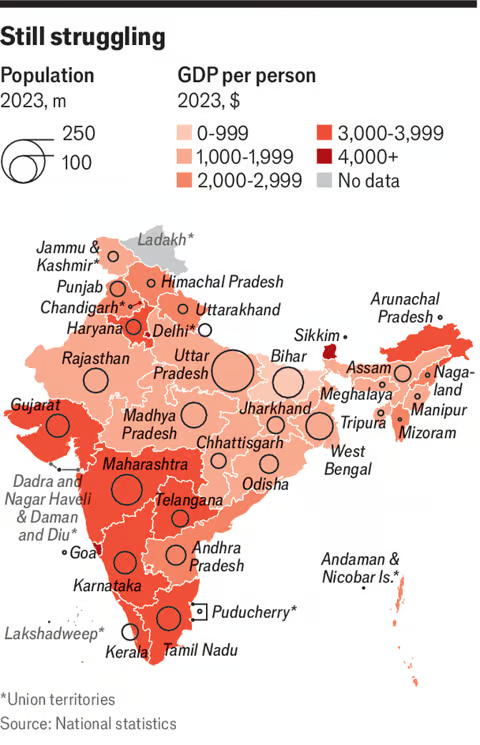Excited to share what I've been up to this year!
On the cover of this week's @TheEconomist is a 6-part special report on India’s economy by Tom Easton+me. It asks
- What it would take for India beat 6% growth?
- And is Modi up to the task?
🧵on the key arguments 1/


On the cover of this week's @TheEconomist is a 6-part special report on India’s economy by Tom Easton+me. It asks
- What it would take for India beat 6% growth?
- And is Modi up to the task?
🧵on the key arguments 1/


2/ India is growing at 6-6.5% a yr, slower than China’s heyday of 10%+
But that's still solid. Growth is harder today bc manufacturing is less of a route to riches
India has the world's #5 economy, by 2027 it will be #3. #1 is even plausible by 2070 economist.com/special-report…

But that's still solid. Growth is harder today bc manufacturing is less of a route to riches
India has the world's #5 economy, by 2027 it will be #3. #1 is even plausible by 2070 economist.com/special-report…

3/ What are India’s strengths?
Ch 1 notes the big shift over the past decade has been better infra–physical+digital. Roads+railways are growing fast. Digital payments and electronic forms work.
This reflects Modi’s forte–executing big projects
Ch 1 notes the big shift over the past decade has been better infra–physical+digital. Roads+railways are growing fast. Digital payments and electronic forms work.
This reflects Modi’s forte–executing big projects

3/ Ch 2+3 continues on India's relative strengths--the financial and corporate sectors
Contra to narratives of crony capitalism, mkt concentration is actually falling in India. Modi favours national champions, but less than you might think economist.com/special-report…

Contra to narratives of crony capitalism, mkt concentration is actually falling in India. Modi favours national champions, but less than you might think economist.com/special-report…

4/ Ch 4 is the tricky trio. It’s well-known that 🇮🇳 is an IT services superpower, but the govt wants it to be a manufacturing power too
There is some success–14% of iPhones are now assembled in India. But corp investment and exports have yet to budge
economist.com/special-report…

There is some success–14% of iPhones are now assembled in India. But corp investment and exports have yet to budge
economist.com/special-report…

5/ Why has🇮🇳struggled to⬆️investment and beat 6% growth?
Historical reforms left state-level red tape on land/labour/power mostly untouched
Mass education remains poor contributing to a weak labour mkt. Strongman govt and rising protectionism don’t help economist.com/special-report…
Historical reforms left state-level red tape on land/labour/power mostly untouched
Mass education remains poor contributing to a weak labour mkt. Strongman govt and rising protectionism don’t help economist.com/special-report…
6/ Our final chapter lays out a reform agenda touching on everything form innovation policy to beefing up city governance
A striking stat: only 15% of Indian govt employees work at the local level vs 60% in 🇨🇳 or 🇺🇸 leading to poor state capacity economist.com/special-report…
A striking stat: only 15% of Indian govt employees work at the local level vs 60% in 🇨🇳 or 🇺🇸 leading to poor state capacity economist.com/special-report…
7/ The problem is that the needed reform requires buy-in from states and social groups that might lose from change. But Modi’s weakness has been building such a consensus
Our leader argues that must change for India to sustain its rise over the long-term economist.com/leaders/2024/0…
Our leader argues that must change for India to sustain its rise over the long-term economist.com/leaders/2024/0…
8/ I'm indebted to colleagues, friends and sources who made this report possible.
Read the full report here:
Acknowledgements: economist.com/special-report…
economist.com/special-report…
Read the full report here:
Acknowledgements: economist.com/special-report…
economist.com/special-report…
• • •
Missing some Tweet in this thread? You can try to
force a refresh












